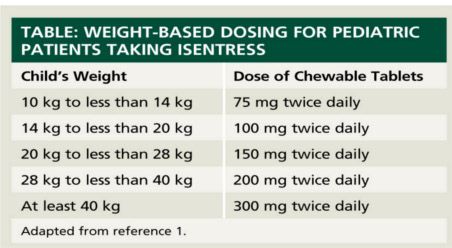New FDA Actions: Merck & Co Inc's Isentress
The FDA approved an expanded indication for Isentress (raltegravir) to include the treatment of HIV-1 infection in children 2 years and older.
The FDA approved an expanded indication for Isentress (raltegravir) to include the treatment of HIV-1 infection in children 2 years and older.
The FDA has expanded the indication of Merck’s Isentress (raltegravir) to include pediatric patients. The new approval indicates Isentress for use in combination with other antiretroviral agents for the treatment of HIV-1 infection in children 2 years and older who weigh at least 10 kg. A chewable tablet formulation (25 mg and scored 100 mg) was also approved.
Isentress first received FDA approval in 2007, but its use was limited to treatment-experienced adult patients with HIV-1. Its indication was expanded in 2009 to include treatment-naïve adult patients with HIV-1.1,2
Pharmacology and Pharmacokinetics
HIV-1 integrase is an encoded enzyme involved in viral replication. Isentress exerts its effect by inhibiting the catalytic activity of this enzyme, thus preventing the formation of the HIV-1 provirus. Without the provirus, the production of progeny virus cannot occur. As a result, the viral infection cannot be propagated.
Neither race nor gender affect the pharmacokinetics of Isentress.1
Dosage and Administration
Isentress is available as a 400-mg film-coated tablet, a 25-mg chewable tablet, and a 100-mg chewable tablet. The 400 mg film-coated tablet is not interchangeable with the 25- or 100-mg chewable tablet formulations.
Children 12 years and older should receive one 400-mg filmcoated Isentress tablet twice daily. Children aged 6 years to younger than 12 years who are at least 25 kg in weight should receive either one 400-mg film-coated Isentress tablet twice daily or a weight-based chewable tablet dose (Table), to a maximum dose of 300 mg twice daily. Children aged 6 years to younger than 12 years who weigh less than 25 kg should receive a weight-based chewable tablet to a maximum dose of 300 mg twice daily. Children aged 2 years to younger than 6 years who are at least 10 kg should receive a weight-based chewable tablet dose to a maximum dose of 300 mg twice daily.
The 400-mg film-coated tablet must be swallowed whole. Isentress can be given with or without food.1

Clinical Trials
The approval for pediatric patients was based on data from a Phase I/II 24-week, open-label, multicenter trial that evaluated the pharmacokinetic profile, safety, tolerability, and efficacy of Isentress in HIV-1— infected children and adolescents with optimized background therapy. The study included 126 treatment-experienced HIV-1– infected children (aged 2-18 years), most of whom had previously used at least 1 nonnucloeoside reverse transcriptase inhibitor or 1 protease inhibitor.
Ninety-six patients used either the 400-mg film-coated tablet or the chewable tablet, given twice daily in combination with optimized background therapy. At baseline, the mean plasma HIV-1 RNA was 4.3 log 10 copies/mL, and the mean CD4 cell count was 481 cells/mm3. Ninety-seven percent of patients continued treatment for 24 weeks. At 24 weeks, 54% of these patients had a mean plasma HIV-1 RNA of less than 50 copies/ mL, and the mean CD4 cell count increased by 119 cells/mm3 from baseline.1,2
Contraindications, Warnings, and Precautions
There are no contraindications to treatment with Isentress.
Severe, potentially life-threatening and fatal skin reactions, including Stevens-Johnson syndrome, hypersensitivity reaction, and toxic epidermal necrolysis, have been reported. Discontinue treatment immediately if severe hypersensitivity, severe rash, or rash with systemic symptoms or liver aminotransaminase elevations occur. Patients should be monitored for immune reconstitution syndrome. Patients with phenylketonuria should be warned that the chewable tablets contain phenylalanine.
Concomitant administration of Isentress with strong inducers of UGT1A1 may result in decreased Isentress plasma concentrations. Isentress is Pregnancy Category C and should only be used if the potential benefit outweighs the potential risk. Isentress should not be used in patients who are breastfeeding. Creatine kinase elevations with reports of myopathy and rhabdomyolysis were noticed in patients using Isentress. Use cautiously in patients at risk for myopathy or rhabdomyolysis. Isentress should not be used in children younger than 2 years.
The most common adverse effects (≥2%) are insomnia, headache, nausea, and fatigue.1
Dr. Holmberg is a pharmacist who resides in Phoenix, Arizona.
References
1. Isentress complete prescribing information. Available at http://www.merck.com/product/usa/pi_circulars/i/isentress/isentress_pi.pdf Accessed June 2012.
2. FDA Approves Merck’s ISENTRESS® (raltegravir) for Use in Children Ages Two Years and Older as Part of HIV-1 Combination Therapy. Available at http://www.isentress.com/isentress/hcp/documents/isentress_press_release.pdf

